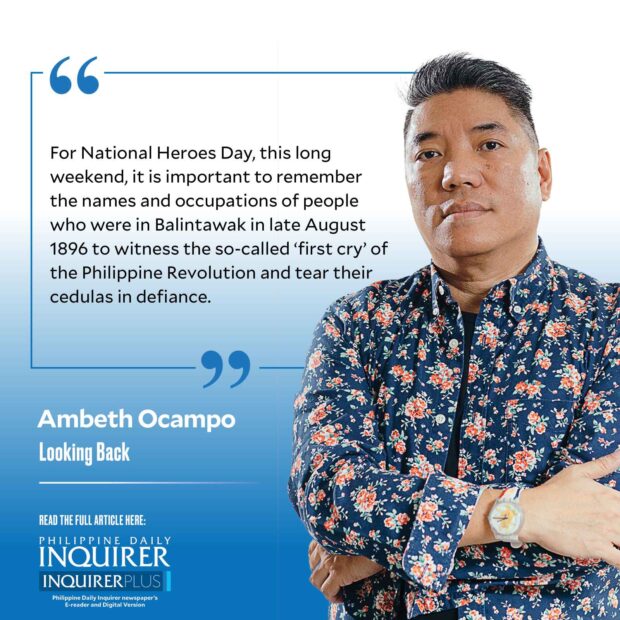Insight from trivia
Many people imagine that books are the products of individual authors who retreat into solitude with pen and paper (or laptop) to write, write, and write. In my case, most of my books are compilations of essays that originally appeared on the editorial page of the Inquirer. Some people do not consider these “real books.” The late Carmen Guerrero Nakpil made me promise to publish a “real book” someday and not just essay collections. Teodoro Agoncillo, early on, warned me that columnists used to churning out 800 word essays will struggle to write—long form. When I was stumped during the writing of a doctoral dissertation, my supervisor advised that I learn to “argue a point in 50 pages” and when I had eight to 10 chapters of about 50 pages each, the thesis was done.
My fear of the blank page has been alleviated by two authors whose books were born from online writing. Retired Justice Adolfo Azcuna, published vignettes on Facebook that were compiled and edited into a delightful autobiography “Silver is my Gold” (Milflores Publishing, 2023). Then, there were Jim Richardson’s essays and primary source material on the Philippine Revolution originally published in two blogs that compiled and augmented with primary source documentation both in the original Tagalog and an English translation grew into the magisterial “The Light of Liberty: Documents and Studies of the Katipunan, 1892-1897” (Ateneo de Manila University Press, 2013).
I leaf through Richardson each year, first in June in search of topics for Independence Day, then in August and November in search of topics for Andres Bonifacio and the Philippine Revolution of 1896-1897. Richardson had gone over the signatures on the June 12, 1898 declaration of Philippine independence from Spain, listed most of them down (except for a handful that were illegible), and from this list gave us a sense of the composition of “founding fathers” who made history in Kawit that afternoon. The names of the representatives in the Malolos Congress and the regions they were elected or assigned to tell us a lot about the short-lived Philippine Republic.
For National Heroes Day, this long weekend, it is important to remember the names and occupations of people who were in Balintawak in late August 1896 to witness the so-called “first cry” of the Philippine Revolution and tear their cedulas in defiance. In an interview, Guillermo Masangkay gave “Bagong Buhay,” he provided names and occupations of each Katipunero.There were five printers: Aguedo del Rosario and Apolonio de la Cruz (Diario de Manila), Alejandro Santiago (El Resumen), Deogracias and Juan Fajardo (affiliation unknown). Six tobacco workers: Patricio Belen, Crispulo Chacon, Lorenzo Martinez, and Tomas Villanueva, plus a master tobacco maker (Pio H. Santos) and a master cigar-maker (Tomas Alegre). Four were mechanics: Rogelio Borja, Isaac del Carmen, Hilario Sayo, and Ramon Bernardo who was also former municipal captain of Pandacan. Two were draftsmen: Melecio Ruestra and Pastor Santos. Two were “kuridor” best described as “buy-and-sell” Guillermo Masangkay and Pedro Zabala.
Richardson notes that it is significant that more than half of the Katipuneros on the list were government employees. Three were treasury clerks: Tomas Remigio, Pantaleon Torres, and Vicente Molina. Seven were connected with customs: Calixto Santiago, Restituto Javier, and Herminigildo Reyes were customs officials; Valentin Lagasca and Eugenio Santos were customs guard sergeants. Francisco Carreon and Sarhento Marcelo were customs guards, though Marcelo must have been a sergeant either demoted or aspiring? Four were court clerks: Briccio Pantas, Teodoro Plata (Mindoro Court of First Instance), Jose Trinidad (Tondo Court of First Instance), and Hermogenes Plata. Two were arsenal employees: Roman Ramos and Tito Miguel. The list even includes three government secret agents! Julio Navarro, Alejandro Andaya, and Marcelo Badel were double agents who fed sensitive information to the Katipunan and false information to the Spanish government.
Contrary to popular belief, not all Katipuneros were poor as there were two property owners—Estanislao Vargas and Apolonio Samson. Some had higher education like the physician Pio Valenzuela. Andres Bonifacio was a warehouseman at Fressel and Co., his brother Procopio a railway baggage master. Emilio Jacinto was a student. Salustiano Cruz was a tailor. Juan Cruz was both a barber and playwright. Nicomedes Carreon, a “cobrador” or debt collector. Miguel Resurreccion, a “zacatero” or grass cutter. Vicente Leyva, a “lechero” or milk seller. Macario Sakay, a “personero” or sales agent.
It is a pity that we have lost our appreciation for useless information. On the surface, listings like these seem to be insignificant trivia, but knowing the occupation, educational attainment, and general background of each individual provides deeper context into our history that can generate new insights.
—————-
Comments are welcome at aocampo@ateneo.edu





















